- Home
- Paint Ocean
- Ocean Colors
How to Paint Ocean Colors
Learning how to paint ocean colors can bring your canvas to life in ways you never imagined.
If you’ve ever visited the ocean and marveled at its stunning colors, you’re not alone.
The ocean is beautiful blues and greens, and sometimes turquoise.
Painting the ocean offers a wonderful opportunity to express our creativity. Understanding the colors is essential for any artist looking to capture the many moods of the ocean.
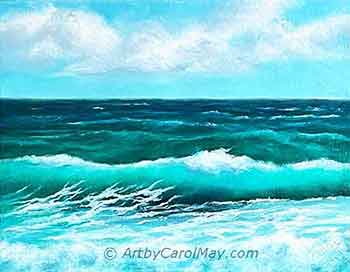 The ocean is a variety of colors.
The ocean is a variety of colors.This page provides you with:
- The colors we use to paint the ocean.
- How to mix the ocean colors.
- A tutorial on how to paint ocean colors.
- Examples of how colors were used in seascape paintings.
Painting the ocean is not just about mixing colors. It’s about understanding how light, water, and atmosphere interact to create those wonderful seascapes.
Examples of How to Paint Ocean Colors
The many moods of the sea show in its colors.
What color we paint the ocean depends on the light and the weather. Is it sunny or cloudy? Is it a stormy or a calm day?
Ocean colors also differ between deep water, shallow water and water on the beach. Let's look at a few examples in paintings.
Ocean Colors from Turquoise to Deep Blue
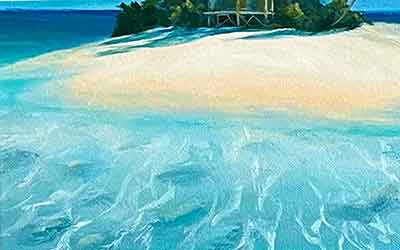
Shallow water is a variety of turquoise to aquas and warm greens.
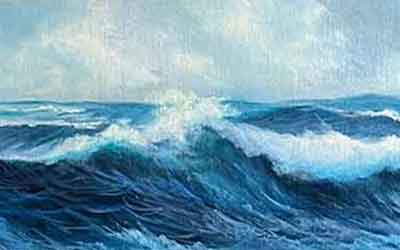
Deep ocean away from land is dark blue, sometimes almost black with purple.
Ocean Colors on Sunny or Cloudy Days
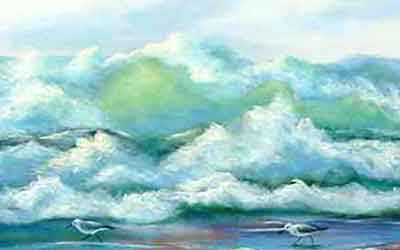
Sunny days create warm greens, turquoise and aqua in the ocean water.
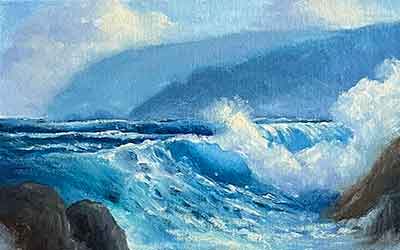
Cloudy or stormy days change the ocean colors to a variety of cool blues.
The Ocean from Sunset to Sandy Beaches
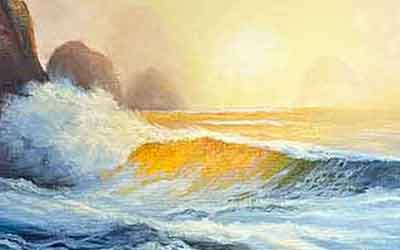
Sunset and sunrise paint the water with the yellow, orange or reds of the sunlit sky.
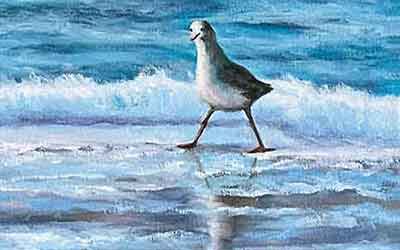
Thin sheets of water on the beach are tinted by the sand colors seen through the water.
NASA tells us: What color is the ocean?
What Colors Do We Use to Paint the Ocean?
What's the best blue for painting ocean? We have a couple of good choices.
- Ultramarine Blue is most often used for painting ocean scenes. It's a warm blue that leans slightly toward red. When it's mixed with white, it creates lovely purple shadows.
- Phthalo Blue (green shade) is very useful for seascape paintings. It's easy to use for the dark blues of deep water. And when it's mixed with yellow it creates beautiful greens.
- Cerulean Blue is a light, bright blue with a hint of green. It's useful for some of the lighter ocean colors. It's the perfect color for painting skies.
- Cobalt Blue is a very beautiful blue used by many artists. It's not in my studio because of some toxicity issues.
Greens are valuable for ocean paintings.
- Viridian Green is a staple color for ocean artwork. It mixes very well with Ultramarine Blue to make the transition from the deep-water blues to the shallow-water greens and aquas.
- Phthalo Green, like its counterpart Phthalo Blue is a very strong color. A little bit goes a long way. It is transparent and mixes well with other colors used in ocean artwork.
Sunshine colors:
- Any of the yellows work for ocean paintings. The cadmium yellows are often used. Raw Sienna and Yellow Ochre are good colors for the beach and water highlights.
- Burnt Sienna is a staple orange that mixes well with Ultramarine for dark water and with white for highlights. Cadmium Orange and others may be used for brilliant sunset colors.
- Alizarin Crimson is a standard red that mixes with green for dark neutrals and with white for rosy skies. Cadmium Reds are opaque and tend to make 'mud' when mixed with other colors.
- Cadmium-free yellows, oranges and reds are my preference.
How to Paint Ocean Colors Like a Pro!
A good reference is important. Most artists even the pros, paint from a live reference or a photograph.
Here's a lovely photo showing the colors of the ocean. We'll use it for this painting tutorial.
Ocean water in its depths is dark blue. As the water gets shallower, it changes to green and finally beautiful turquoises.
You can look for copyright free photos on Pixabay or Dreamstime.
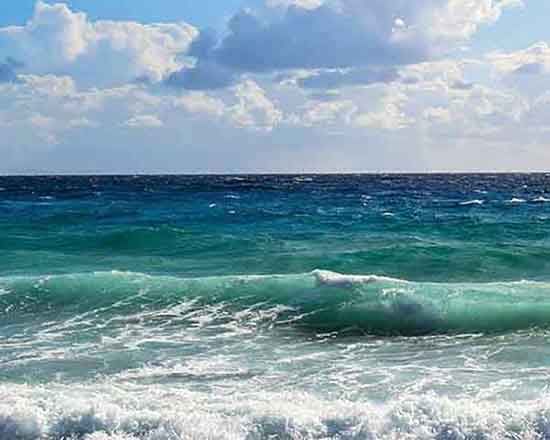 Let's paint the ocean colors!
Let's paint the ocean colors!How to Paint Ocean Colors
Using the above photo as a reference, we will paint a small seascape with an artist's flare.
This painting is on a 11x14 inch stretched canvas. Canvas boards are also suitable for practice paintings. This painting could easily be enlarged to 12x16 or any size you desire.
The brushes used on this small canvas were a #4 flat and bright for the sky and water. A #3 filbert for the foam on the top of the wave and #1 round for the foam trails.
Hog bristle or firm synthetic brushes are best for oil ocean paintings.
The painting may be done with oil, alkyd or acrylic. This painting is alkyd. Alkyds handle the same as oils, but dry much faster.
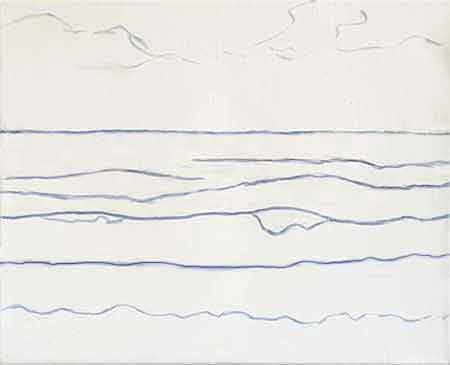 Sketch the composition on the canvas.
Sketch the composition on the canvas.Outline the composition on the canvas with paint that's thinned with odorless mineral spirits.
We'll pretty much follow the photograph for an easy composition.
We don't center the horizon line. Notice it's above the center of the canvas.
That give us plenty of area to paint the ocean colors.
On the 11x14 canvas the horizon line is 4 inches down from the top of the canvas.
Make sure the horizon line is level.
What Colors Do We Use in Our Ocean Painting?
We will paint with a limited palette. It only takes three or four colors to paint the ocean.
- Yellow Ochre or Cadmium Yellow Light
- Burnt Sienna
- Ultramarine Blue or Phthalo Blue, green shade
- Titanium White
Cerulean Blue is optional for the sky.
We can easily paint a level horizon on a small canvas.
But on a large canvas, it's a good idea to measure down from the top on each side, mark and then draw the horizon line with a straight edge.
How Do We Mix the Ocean Colors?
The ocean behind the wave will be painted with three colors from the horizon down with dark blue, changing to teal and then green.
- Ultramarine Blue is mixed with a little Burnt Sienna for the dark blue water.
- Make a teal green by adding green and a tiny bit of white to the dark blue mixture.
- Mix Viridian, a little Burnt Sienna with yellow and white to make the green water.
The turquoise colors of the wave are Ultramarine Blue, Viridian and white. If the color is too garish, moderate it with a little Burnt Sienna.
How to Paint the Ocean Colors Step by Step
Underpaint the background ocean starting at the horizon with a flat brush. We will paint the three different mixed colors, one after another.
Stroke the dark blue from side to side. The strokes don't have to be smooth. The stroke lines and variations show movement in the water. Leave them.
Blend the teal into the bottom edge of the dark blue and paint down.
Then paint the mixed green color down to the top edge of the wave.
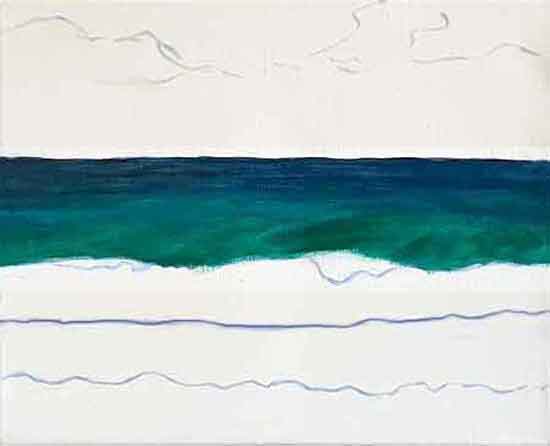 Ocean underpainting
Ocean underpaintingUnderpaint the Wave
We will underpaint the wave with three different colors.
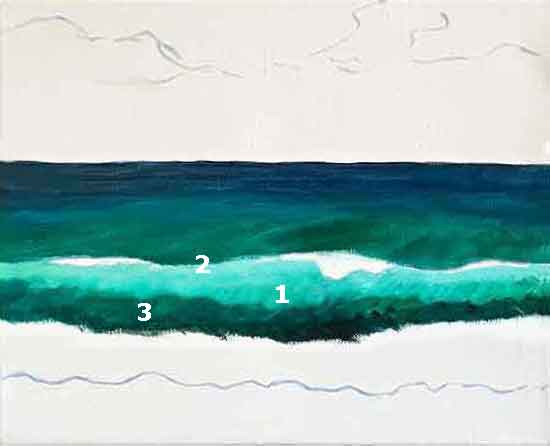 Underpaint the 3 colors, then blend the transitions.
Underpaint the 3 colors, then blend the transitions.- Mix Viridian with a little Ultramarine and white for the color the middle of the wave. Start painting in the middle of the wave. Stroke in the direction the water is moving.
- As you near the top edge of the wave add white to lighten the color.
- Clean your brush and mix Ultramarine and Burnt Sienna for the shadow color at the bottom of the wave. Brush the color on in the direction of the water.
Blend the three different colors for a smooth transition between the colors. The blended colors show in the next photo.
Underpaint the Foreground Water
After underpainting the wave, wipe the extra paint off the brush and gently blend the shadow color into the middle color. Leave the lightest color at the top of the wave untouched.
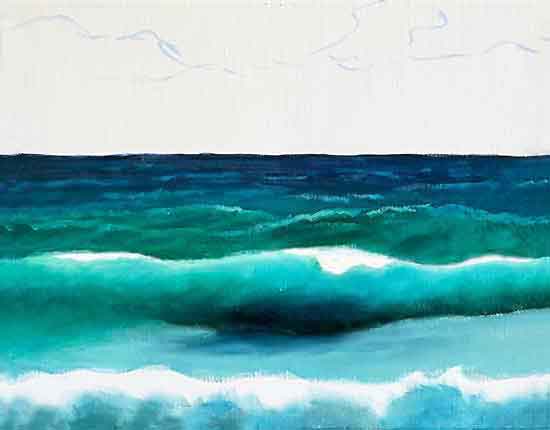 Paint the water and foam on the beach.
Paint the water and foam on the beach.The beach water is affected by the sand color showing through the water.
It lowers the color intensity. The horizontal water will also reflect some of the sky color.
Start with the ocean underpainting colors, Ultramarine and Viridian. Add a little Burnt Sienna to lower the intensity of the color. Then add white to lighten the mix.
The sky reflecting on the beach water will lighten its value compared to the wave. Learn more about values.
Let's let the water underpainting set a bit, while we paint the sky.
Painting the Sky
The ocean is the main focus of the painting, so we paint softer clouds compared to the photo.
Ultramarine is a good color for skies, but it needs to be mixed with a bit of green.
Cerulean Blue is a convenience color that already contains a little green. So, we will use it with a touch of Burnt Sienna to dull the blue slightly and a lot of white.
Complimentary colors are always the best way to make color look more natural.
 Paint the sky around the future clouds.
Paint the sky around the future clouds.Paint your own sky imagining where you would like to have clouds. Leave the cloud areas unpainted.
The sky will be slightly lighter toward the source of light on the right. It will be darker toward the left.
Start painting in the upper left corner. As you paint across toward the right, keep adding white. Add white and a tiny touch of green toward the horizon.
Put the paint on with 'x' strokes. Just put the paint on not blending while painting.
Then clean and dry the brush. Use soft, gentle 'x' brush strokes to softly blend the paint from the dark to the light color.
Wipe the excess paint off the brush and soften the horizon line so it looks farther away.
 Paint the warm cloud shadows.
Paint the warm cloud shadows.Paint the cloud shadows with a mixture of Ultramarine, Burnt Sienna and white.
Leave the highlight areas unpainted.
 Paint the highlights with a warm white.
Paint the highlights with a warm white.Mix white with yellow or Burnt Sienna for the highlights of the clouds.
Paint the remaining bare canvas in the sky.
 Softly blend the cloud colors.
Softly blend the cloud colors.Clean your brush and dry it on a rag or paper towel.
Gently blend highlight color toward the blue sky. Then blend the highlights into the shadow color, thus lightening the grey shadow color.
If too much paint collects on the brush, wipe it off on a paper towel. Don't wash the brush at this point. A brush with solvent on it will pull the paint off, instead of blending it.
Painting the Foam
Mix a cool grey for the shadows on the foam.
We use the same mixture as the cloud shadows, Ultramarine, Burnt Sienna and white. But this time we cool it by adding more blue.
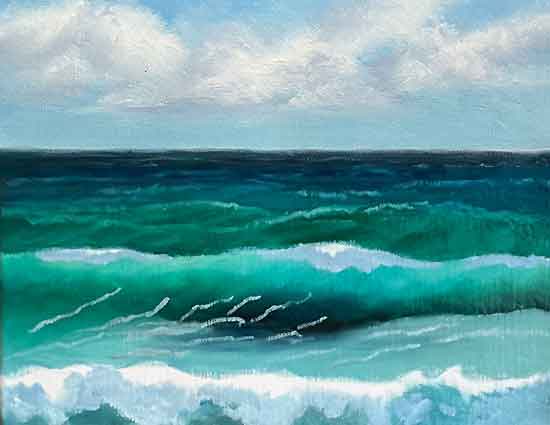 Paint the shadowed foam and foam trails.
Paint the shadowed foam and foam trails.Scrub the shadow color on the foam with a bright or flat brush.
Get the feel of painting a few shadowed foam trails. Paint them in the direction of the water movement using a small round brush.
Highlight the Foam
Mix a warm white with a little yellow or Burnt Sienna and plenty of white.
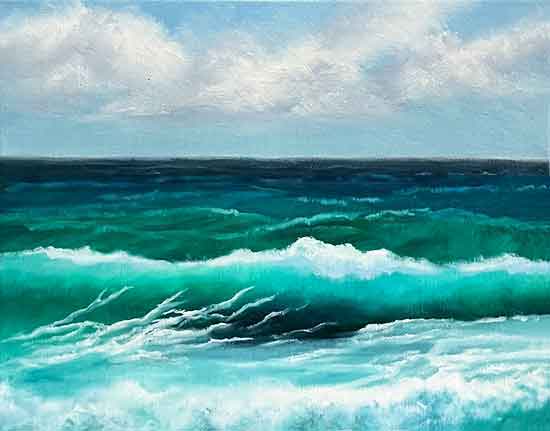 Highlight the foam and paint more foam trails.
Highlight the foam and paint more foam trails.Load the flat or bright brush with plenty of white. Hold the brush sideways with its side edge toward the canvas. (Not the tip of the brush.)
Pull the brush gently across the top of the wave, as it releases the white. It can release the paint hit-and-miss. That's what we want it to do. That looks more natural, rather than a solid line of white.
Be careful to not cover all the shadow color. Gently blend the highlights into the shadow color. If you wish soften some of the top of the highlights.
Finish Painting the Ocean Colors with Highlights
We have learned how to paint the ocean colors. Now we're ready to touch-up and finish the painting.
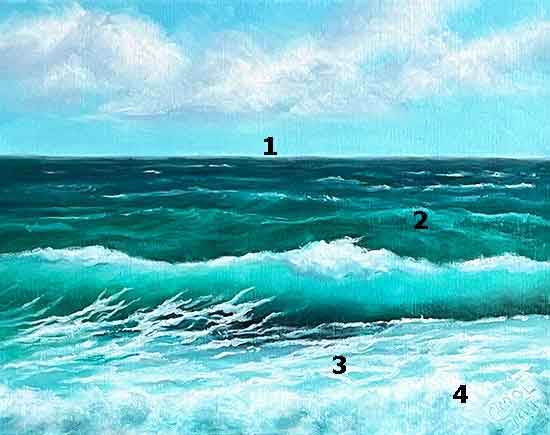 Let's finish painting the ocean colors.
Let's finish painting the ocean colors.- Soften the horizon with a clean brush to make it look farther away. If the water is dry, mix a little of the sky color and scumble it on the horizon with a dry brush.
- Highlight the background wavelets. Mix white with the shadow color from the main wave for the blue and teal wavelets. Highlight the green waves with Viridian, a touch of Burnt Sienna and plenty of white.
- Highlight and soften any edges on the beach water as needed.
- Soften and make any adjustments to the foreground foam roll. You're all finished; it's time for a signature. The bottom right corner is the typical spot.
That's How to Paint Ocean Colors
Learning to paint the colors isn’t just about mixing paint; it’s about capturing the ocean on canvas.
Let the awesome ocean inspire you to paint more. Every painting is a step forward. Don’t hesitate to experiment and make it your own!
As you are painting, explore more pages on ArtbyCarolMay.com. There are lots of resources to help you grow as an artist.
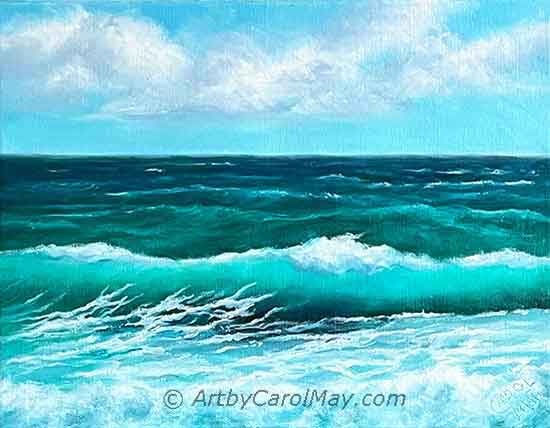






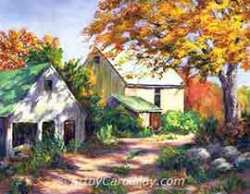 Art elements and principles appear over and over in good paintings. The elements and principles work together for us to create successful artwork. Art principles are the rules that govern how an artis…
Art elements and principles appear over and over in good paintings. The elements and principles work together for us to create successful artwork. Art principles are the rules that govern how an artis…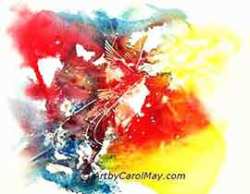 Artists often use the meaning of color to convey emotions, sentiments, and symbolism. Are you intrigued by the idea that colors can enhance or suppress different aspects of your paintings? Let's look…
Artists often use the meaning of color to convey emotions, sentiments, and symbolism. Are you intrigued by the idea that colors can enhance or suppress different aspects of your paintings? Let's look… What is the best painting medium for the artist to begin painting? Compare the pros and cons of today’s popular mediums, oil, watercolor, acrylic and alkyd paint. What is the difference between their…
What is the best painting medium for the artist to begin painting? Compare the pros and cons of today’s popular mediums, oil, watercolor, acrylic and alkyd paint. What is the difference between their…